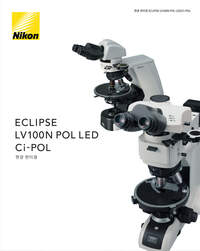- ko Change Region
- Global Site
Outstanding optical performance for a wide variety of imaging applications and polarizing techniques.
The LV100N POL LED is equipped with a bright, long-lasting LED light source which produces minimal heat, reducing heat related focus drift.
- Nikon’s unique stage mount design ensures exceptional stability.
- The nosepiece comes equipped with a DIN standard compensator slot.
- All five objective positions on the nosepiece are centerable.
- Boasts CFI60 infinity optics for high NA and longer standard working distances.
- The clamp-type upper limit focusing mechanism for easy and safe sample exchange while protecting both the sample and optics from collision damage.
- The robust microscope body is designed for stability and years of dependable use.
주요 특징들
Uniform brightness with diascopic illumination
Nikon's unique fly-eye lens employed in the diascopic illumination optics ensures uniform brightness throughout the visual field - perfect for digital imaging.
High-precision rotating stage
The stage is large, pre-adjusted, and has click-stops in 45° increments. The smooth stage movement allows stable and easy rotation, providing high operability and high-quality polarized images.
Because the stage is supported from the bottom near the optical axis and incorporates steel cross roller guides, it offers excellent stability and durability.
- Focus stroke has been improved to 30mm, facilitating observation of tall samples.
- Clamp-type upper limit focusing mechanism makes for easy and safe sample exchange.
Reversed centering quintuple nosepiece
Nosepiece comes equipped with a DIN standard compensator slot to accept various compensators for advanced quantitative measurements. All five objectives are center-able.
Intermediate tube
The intermediate tube incorporates a Bertrand lens as standard, enabling both the observation and capture of conoscopic and orthoscopic images. The Bertrand lens is focusable and centerable. The high precision slider-type analyzer is rotatable for a full 360°.
Objectives for polarizing observation
CFI Achromat P objective series (for diascopic illumination)
The unique Nikon CFI60 infinity optics successfully deliver longer standard working distances and high numerical apertures, offering superb image flatness, contrast and cost performance.
CFI TU Plan Fluor EPI P objective series (for diascopic/episcopic illumination)
The CFI TU Plan Fluor EPI P series of CFI60-2 objectives produce incredibly sharp aberration-free images regardless of magnification.
Nikon CFI infinity optics utilize eco-glass which is manufactured without the use of harmful substances such as lead and arsenic.
CFI P Achromat objective series (for diascopic illumination)
CFI TU Plan Fluor EPI P objective series (for episcopic illumination)
Diascopic/Episcopic illumination type
Both diascopic and episcopic polarizing observations are possible by utilizing the LV-UEPI-N Universal Epi-illuminator. It is possible to switch between illumination techniques of the LV100N POL LED with a simple action. Furthermore, the epi-illuminator uses a bright, long-lasting LED light source equipped with a noise-terminator mechanism to provide sharp images with high S/N ratios.
With an optional universal-type nosepiece and DIC accessories such as objectives, episcopic differential interference contrast (DIC) microscopy is also possible.
Digital Camera for Microscopes
The Digital Sight 100 and Digital Sight 10 cameras are capable of acquisition, processing, measurement, analysis, data management and report creation via NIS-Elements software when connected directly to a PC.
Microscope Color Digital Camera – Digital Sight 100
Equipped with a 17.7-megapixel CMOS sensor.Features include high-speed live display and PC-free observation via HDMI monitor connection.
Digital Sight 10 Microscope Camera (F-mount)
A high-resolution camera for both color and monochromatic image capture up to 6000 x 3984 pixels. This enables the capture of images over a wide area in one shot. Tiled images can be stitched together making a single and large combined image.
Image Software – NIS-Elements LE
A free software package that makes it easy to configure and control microscope digital cameras, display live images, and capture images.
Compatible Cameras: Digital Sight 50M, Digital Sight 10, Digital Sight 100, Digital Sight 1000
(Supported OS: Windows 11 Pro 64-bit) Please contact us regarding PC specifications.
태블릿 PC용 NIS-Elements LE 카메라 제어 소프트웨어


